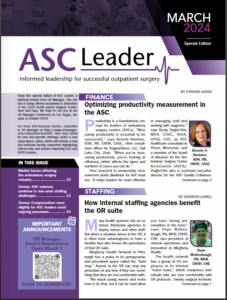
 Subscriber Content ASC staffing and surgical volume drop in response to pandemic
Subscriber Content ASC staffing and surgical volume drop in response to pandemic
Nearly a third (30%) of ambulatory surgery center (ASC) leaders have experienced layoffs of direct care staff during the past year, according to the 2020 annual OR Manager Salary/Career Survey, up from a mere 4% in 2019. COVID-19 is the likely culprit: Most of the comments received in response to…
 Subscriber Content Overcoming failure as a leader
Subscriber Content Overcoming failure as a leader
Conscientious leaders strive for excellence and have high expectations of everyone around them. If you are like me, you may have been told at times to lower your expectations. But I believe if you raise the bar, people worth retaining will meet the bar if they have the support to…
Preoperative protocols enhance outpatient total joint outcomes
On January 1, 2020, the Centers for Medicare & Medicaid Services (CMS) began reimbursing healthcare providers for total hip arthroplasty performed in outpatient hospital settings and total knee arthroplasty in ambulatory surgery centers (ASCs), thereby opening the floodgates for explosive growth in outpatient total joint arthroplasty (TJA). About a million…
 Subscriber Content Agile, data-driven strategy for managing the OR after COVID-19
Subscriber Content Agile, data-driven strategy for managing the OR after COVID-19
As state authorities begin to ease restrictions imposed by COVID-19, physicians, nurse leaders, and administrators face a momentous challenge: resuming elective surgical procedures that have been postponed for several weeks or months. How will they accommodate the looming glut of elective surgery demand with limited infrastructure and staff who are…
 Subscriber Content ASC offsets some revenue loss through 'Hospital Without Walls' waiver
Subscriber Content ASC offsets some revenue loss through 'Hospital Without Walls' waiver
Far fewer cases of COVID-19 have been seen in rural areas of the US than in large urban populations. But even healthcare facilities not inundated with COVID-19 patients have sustained revenue losses and disruptions in standard procedures. One major advantage for Heartland Surgery Center in Kearney, Nebraska, was seeing the…
 Subscriber Content Proactive payment collection reduces bad debt risk
Subscriber Content Proactive payment collection reduces bad debt risk
Establishing policies to collect payment before surgery has grown in importance as high-deductible health plans impose larger out-of-pocket costs on patients. To help manage patients’ expectations about costs and increase the likelihood of collecting payment, some experts believe a culture shift is in order. They say healthcare facilities should be…
 Subscriber Content Self-awareness fosters higher emotional intelligence
Subscriber Content Self-awareness fosters higher emotional intelligence
Everyone has had bad days at work when they may have felt frustrated, sad, angry, stressed, afraid, nauseated, sick, or overwhelmed. Why do some move from experiencing a terrible day at work to leaving the organization, whereas others pull themselves together? How do we rally from burnout, disappointment, frustration, and…
OR leaders chart new territory for resuming elective surgery
Elective surgical procedures that were temporarily suspended in mid-March are now on the table—or soon will be—at some US facilities. The ban, announced on March 18 by the Centers for Medicare & Medicaid Services (CMS), was enacted to free up resources for facilities overwhelmed by surges of COVID-19 patients. On…
 Subscriber Content Editorial
Subscriber Content Editorial
Coronavirus cases in the US topped 1 million in late April. Although total numbers of cases and deaths change daily and vary greatly among urban vs rural regions of the country, it’s safe to say we haven’t yet seen the last of the surges. Despite ongoing shortages of personal protective…
 Subscriber Content ASCs following new rules for safety during pandemic
Subscriber Content ASCs following new rules for safety during pandemic
Coronavirus Disease 2019 (COVID-19) is a global pandemic that led the United States to declare a national emergency and implement a ban on all elective diagnostic and therapeutic procedures, as well as elective surgery in inpatient and outpatient settings. On March 19, the Ambulatory Surgery Center Association (ASCA) released guidance…


